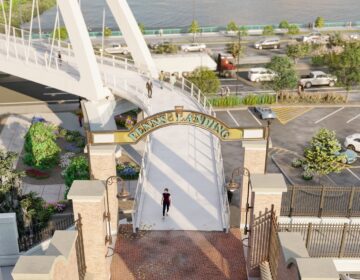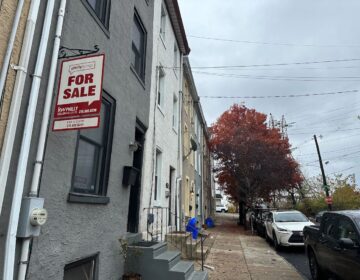PCPC starting to “Imagine Philadelphia”

Dec. 4
By Alan Jaffe
For PlanPhilly
The city is in a planning phase.
PennPraxis unveiled its Civic Vision for the Central Delaware last month. Great Expectations, a year-long effort coordinated by The Inquirer and the University of Pennsylvania, unrolled its agenda at a Citizens Convention last Sunday.
And tonight, the City Planning Commission launched its civic engagement project, Imagine Philadelphia.
The first of eight meetings scheduled in various neighborhoods was held at the Fels Community Center in South Philadelphia, where about 100 residents were asked for their input and “big ideas” on how to improve the city and its reputation within and beyond its borders. It is the initial phase in the drafting of a new comprehensive plan to guide development throughout Philadelphia.
CPC executive director Janice Woodcock explained that the commission is “starting with the citizenry for this citywide planning effort.” Philadelphia is “at a special moment,” she said, when land use issues are at the forefront of municipal concerns. The Zoning Code Commission has been created to reform the current code and rethink how the city will grow in the 21st century. “We need better, fairer, smarter regulations” to guide that future, she said.
With images of the city’s past and present on a screen beside him, Alan Urek, director of the CPC strategic planning and policy division, noted “major transformative efforts” that have been accomplished with careful planning. They included the creation and spread of the Fairmount Park system; the regional transit system; plans to turn the Philadelphia Navy Yard into a mixed-use development; the post-war housing developments in the Northeast; the Market Street El in the west; and the Ben Franklin Parkway.
The Planning Commission is now charged with laying the foundation for new citywide efforts. That will involve informing the public of its intentions; listening to their concerns; pulling together relevant work and data; and positioning the city to move ahead, Urek said.
The first phase, which began Tuesday night, is “information gathering,” he continued.
Now is the time to undertake such an effort, Urek said, because of several forces at work: the shifting population, regional growth, debates over preservation and new construction, changing land use issues, a renewed interest in cities, changing transportation needs, and concern for sustainability. “We need to think about how we’re going to leave things for future generations,” and ensure that they are “more rich, not depleted,” he said.
The citizen participants from throughout the city were then asked to spend about 40 minutes in small groups discussing one of eight municipal topics: regionalism, open space and environment, economy, neighborhoods, public services and utilities, housing, transportation, and culture and tourism.
They often turned into wide-ranging and overlapping conversations about the priorities and problems in Philadelphia.
In a discussion of public services and utilities, Chuck Bode, a University City resident who works both for Septa and for a transportation planning firm, said Philadelphia needs to find a way to revive its economic engines. “We’re losing the economy” to the suburbs, he said, and no major corporations make their home here anymore. “We need to make Philadelphia important to the world again.”
There were two overriding themes in the discussion of public services: how to create a school system that worked and a city government that worked.
Carla Puppin, a Bella Vista resident who teaches art history at the Curtis Institute, said there is a citywide need for a more educated workforce and citizenry. She also emphasized the need for honest officials in city government, and she lamented “the deep pool of no return” when residents seek help from some municipal agencies.
At the end of the evening, the small groups summarized their “big ideas” to improve the city. The open space group recommended that the city plan how to help residents, not just tourists. It urged the creation of projects that would serve as national models, whether they be green roofs or water purification efforts. The group also called for the appointment of a city planner to focus on the waterfronts.
The neighborhoods group sought cleaner streets, and it recommended a stronger emphasis on the uniqueness of communities and their retail business resources. The culture and tourism group suggested the creation of a signature attraction on the waterfront, whether it’s a new performance venue or a water park. The transportation group called for an improved Septa system, but also a focus on alternative modes of travel. The economic development group suggested that the city support self-sustainable, neighborhood businesses and bring in fewer chain corporations. The housing group said housing design decisions should be in the hands of citizens. The regionalism group said the “localism” practiced by city politicians blocks the benefits of regional cooperation.
Woodcock said the Planning Commission will post the recommendations gleaned from the eight neighborhood meetings at the conclusion of that phase, and seek more feedback, on the website www.imaginephiladelphia.org. Policy papers consisting of expert and public opinion will be prepared by the end of the summer for presentation to city officials.
She said CPC has long maintained community liaisons in the past, but the current project “is a different style” of gathering neighborhood input and insight. She cited the models of civic engagement used by PennPraxis and Great Expectations, and acknowledged the similar goals of those projects. She said it will be up to the new mayor to coordinate and blend those efforts together.
Alan Jaffe is a former Inquirer editor. Contact him at alanjaffe@mac.com
WHYY is your source for fact-based, in-depth journalism and information. As a nonprofit organization, we rely on financial support from readers like you. Please give today.






